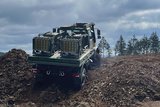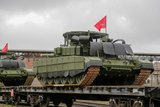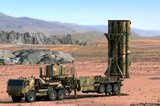Sweden takes delivery of first M3 amphibious bridge and ferry system
The M3 system in action. (Picture: GBELS)
The Swedish Defence Materiel Administration has taken possession of its first M3 amphibious bridge and ferry system from General Dynamics European Land Systems (GDELS).
The first rig is among the first of four batches ordered by Sweden, and when they have all been delivered, Sweden will become the third major NATO player to make extensive use of the technology, alongside Germany and the UK.
The M3 system can operate a fleet capable of negotiating a total of 400 metres (more than 1,300 feet) width. With the addition of the right coupling adapters, the M3 can also be applied with the IRB (Improved Ribbon Bridge) and SRB (Standard Ribbon Bridge) pontoon bridge systems.
Related Articles
According to GDELS, the M3 is the fastest available means for wet gap crossing currently deployed within NATO. It can be used as a floating bridge or ferry to carry the heaviest main battle tanks (currently, within NATO, the Challenger 2) to negotiate wide gaps that require amphibious transport. The system has already been used in a wide range of climates and topographies by the armies of existing customer-nations, including the US, Germany and South Korea.
The 4x4 M3 has a maximum road speed of 80km/h, and multiple M3s can be joined by ramps and adapters, allowing heavy artillery to cross rivers in relative ease in “bridge mode”. The technology can be deployed in this static way to build an “instant bridge”, but when a small number of M3s are joined together they can also act as an active wet gap transport platform for main battle tanks (MBTs), to find optimal disembarkation points to join any engagement.
GDELS said it expected Sweden’s use of the technology to give NATO as a whole “a significant increase in its overall combat engineering capabilities”.
Related Equipment in Defence Insight
More from Land Warfare
-
![Hanwha awarded $482 million in major step for South Korea’s missile defence programme]()
Hanwha awarded $482 million in major step for South Korea’s missile defence programme
The deal to produce and supply launchers and missiles to South Korea follows a contract placed with Hanwha Systems last month for the manufacture of multi-function radars.
-
China goes for ground-launched attack weapons as it strengthens deterrence strategy
China has been advancing its capabilities with a new generation of precision-guided artillery and loitering munitions, positioning ALIT’s WS-series as direct competitors with Western systems like the US’s M982 Excalibur.
-
![Land forces review: British Army vehicle programme stalls and company results land]()
Land forces review: British Army vehicle programme stalls and company results land
In the first monthly review of land forces stories, the Shephard team looks back to evaluate the major news events that have impacted the sector. The UK’s Land Mobility Programme was notable but another setback occurred when a market industry day was scrapped.
-
![Sweden boosts air defence capabilities with Diehl Defence, Saab and MBDA orders]()
Sweden boosts air defence capabilities with Diehl Defence, Saab and MBDA orders
The orders continue the country’s growing investment in its air defence systems across land and sea, coming months after previous investments by the government into IRIS-T SLM equipment.
























